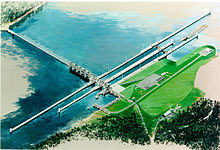Olmsted Locks and Dam
| Olmsted Locks and Dam | |
|---|---|
 Rendering of Olmsted Locks and Dam. | |
| Location | |
| Coordinates | 37°11′02″N 89°03′49″W / 37.1838°N 89.0635°W |
| Construction began | December 1995 |
| Opening date | 2018 (Scheduled) |
| Construction cost | Estimated $2.918 billion |
| Operator(s) | United States Army Corps of Engineers Louisville District |
| Dam and spillways | |
| Impounds | Ohio River |
| Height | 62 feet (19 m) |
| Length | 2,596 feet (791 m) |
The Olmsted Locks and Dam is a locks and concrete dam project currently, as of November 2017, under construction on the Ohio River at river mile 964.4. It's being built to reduce tow and barge delays by replacing the existing older—frequently congested—locks and dams Number 52 and Number 53. The locks are located about 17 miles upstream from the confluence of the Ohio and Mississippi rivers at Olmsted, Illinois.
The project is both the largest and the most expensive inland waterway project ever undertaken in the United States.[1]
History
The US Congress first approved a $775 million budget for the project in 1988.[1] The lock chambers, completed in 2002, are 110 feet (34 m) wide and 1,200 feet (370 m) long.[2]
According to the US Army Corps of Engineers, the new dam and locks will reduce passage time to under one hour with the new system.[citation needed] Due to queuing at Lock and Dam Number 52 and Lock and Dam Number 53, it can take cargo traffic 15 to 20 hours each to transit the locks the Olmsted complex is intended to replace.[3]
When initiated the complex was projected to cost $775 million.[3] As of November 2016, the estimated cost of the project is approaching $3 billion.[1][3]
While the project was initially scheduled for completion in 1998, by 2016 it was projected to become operational between 2018[3][4] and 2020.[5][6] The New York Times reports that, according to the United States Army Corps of Engineers, the Federal agency responsible for maintaining navigation on the USA's rivers, the delay in completing the lock complex costs $640 million per year, due to delays at the aging locks at Lock and Dam Number 52 and Lock and Dam Number 53, which it will replace.[3]
See also
References
- ^ a b c Schneider, Keith (August 18, 2014). "On Books Since 1988, Ohio River Dam Project Keeps Rolling Along". The New York Times. Retrieved December 30, 2016.
- ^ "Olmsted Locks and Dam - Project Description". U.S. Army Corps of Engineers. Retrieved November 1, 2013.
- ^ a b c d e Kelley, Tyler J. (November 23, 2016). "Choke Point of a Nation: The High Cost of an Aging River Lock". The New York Times. Retrieved December 30, 2016.
- ^ Mariano, Nick. "Years overdue, billions overbudget: Olmsted engineers predict the project will be operational in 2018". The Southern Illioisian. Retrieved November 27, 2016.
- ^ Schimmel, Becca (September 14, 2016). "'Sticky Wicket' Clogs Ohio River Traffic". WKMS NPR. Retrieved December 30, 2016.
- ^ Cavagnaro, Hank. "Ohio River Locks and Dam 52 reopens". KFVS12.com. Retrieved November 27, 2016.
External links
- Buildings and structures in Ballard County, Kentucky
- Buildings and structures in Pulaski County, Illinois
- Dams on the Ohio River
- Dams in Illinois
- Dams in Kentucky
- Locks of the United States
- Buildings and structures under construction in the United States
- Dams under construction
- United States Army Corps of Engineers dams
